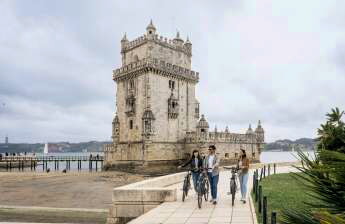A must see in Lisbon, Belem Tower is a UNESCO World Heritage Site and one of the city's most iconic landmarks. Paired with the nearby Jeronimos Monastery, it's an important symbol of Portugal's maritime heritage.
The tower is easily accessible via a short bridge. Inside, you'll find intricately designed rooms and views over the river.
Getting There
Located on the riverside of the city, the UNESCO World Heritage-listed Belem Tower is one of Lisbon's most iconic sights. Built by King Manuel I in the 16th century to defend the city and its nearby forts, Belem Tower is a stunning example of Manueline architecture.
Once you've climbed to the top of the tower, you can explore its many rooms and corridors. It also has an exhibition on Portugal's maritime history, including models of ships and artefacts from the period.
You can get to Belem Tower from central Lisbon by train, bus or tram. If you want to save time and money, we recommend purchasing the Lisboa Card, which gives you free access to public transport and a number of other monuments, museums and attractions in the city.
A visit to the Belem district is a must for any visitor to Lisbon. In addition to the Belem Tower, you'll find other fascinating attractions like Jeronimos Monastery and the National Archeological Museum. Plus, you can sample Lisbon's famous custard tart dessert, known as Pasteis de Belem!
Climbing to the Top
If you’re traveling to Portugal, one of the best things you can do is visit Belem Tower. This iconic structure is located next to the River Targus and is a must-see attraction for anyone visiting Lisbon.
Historically, Belem Tower was a military fortification built in the 16th century to protect the city of Lisbon from enemies. However, it also served as a ceremonial gateway to the city, making it one of the most significant symbols of Portuguese history during the Age of Discovery.
As a fortification, Belem Tower was equipped with 17 canons that were permanently facing the water to protect the city from attacks. Unfortunately, the tower was attacked by the Duke of Alba in 1580, and Portuguese troops surrendered. This led to the construction of a dungeon inside the tower to house the prisoners. That dungeon would continue to be used for several centuries as a prison until 1830.
Inside the Tower
The iconic Tower of Belem is one of Lisbon’s most popular landmarks, and it is also a UNESCO World Heritage site. Designed by military architect Francisco de Arruda, the fortress was built between 1514 and 1520 to protect the mouth of the Tagus River as a gateway to Lisbon.
It served as a military fortification and ceremonial gateway until it was attacked by Spain in 1580. It then became a prison, serving as such for most of its existence.
During your visit, you’ll want to take time to admire the view from the lower level of the tower. It has a spectacular view of the Tagus River, 25th April Bridge, and Belem neighborhood. Then, you can take the narrow spiral staircase up to the first floor of the tower. The first floor houses the Governor’s Chamber and bartizans (corner turrets). There’s a small loggia to enjoy the views. From here, you can see about 30 kilometers of the coastline – Cascais, Estoril, and Sintra.
Views from the Top
Belem Tower is a UNESCO World Heritage site and a must-see on any trip to Lisbon. The views from the top are breathtaking and you will not want to miss them.
This defensive fortification was built along the Tagus River to defend Lisbon from hostile ships. You can climb the narrow steps to the rooftop terrace for a panoramic view of the waterfront and the city.
There are several ways to get to Belem Tower, including by bus, tram, or taxi. However, a fun option is to take a tuk-tuk, which will get you there in less time and for an affordable price.
The tower was ordered by King Manuel I between 1514-1520 to commemorate Vasco da Gama’s voyage to India. It was initially a defense structure, but later became a customs house and a telegraph station. It is considered one of the best examples of Manueline architecture. Its Moorish influences are evident in the decorative details on its arched windows and balconies.









